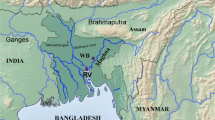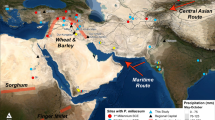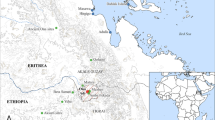Abstract
Here we report the results of an archaeobotanical study carried out on Ceramic Neolithic (2700–2000 bc) and Kushan period (ad 100–300) deposits at Kanispur, Kashmir, northern India. Botanical evidence from the Ceramic Neolithic phase reflects a nascent agriculture based on cold-tolerant crops (barley, wheats, lentil, field pea and grass pea) related to farming patterns of adjacent cultures and possibly evidence for the earliest cultivation in the valley. The Kushan period is characterized by a double-cropping pattern, suggesting a change in agricultural practices associated with a population recovery following a post-Neolithic decline. Finds of Juglans regia, and Prunus cf. amygdalus shells in ceramic Neolithic levels, and Vitis cf. vinifera, Emblica officinalis and Ziziphus cf. nummularia in addition to J. regia, and P. cf. amygdalus during Kushan times suggest that horticulture and foraging played an important role in the diet of the occupants. The present dataset provides new absolute dates for the subsistence economy of the Ceramic Neolithic population in the Kashmir Valley. We also present the oldest directly dated wheat and barley in Kashmir.








Similar content being viewed by others
References
Agrawal DP (1988) Palaeoclimatic data from Kashmir: a synthesis and some correlations. Proc Indian Natl Sci Acad Part A 54:333–342
Bandey AA (2009) Prehistoric Kashmir: archaeological history of Palaeolithic and Neolithic cultures. Dilpreet Publishing House, New Delhi
Beer R (2007) Reconstruction of the Holocene vegetation and fire history in different forest types of Kyrgyzstan, Central Asia. PhD Dissertation, University of Bern
Betts A, Jia PW, Dodson J (2013) The origins of wheat in China and potential pathways for its introduction: a review. Quat Int 348:158–168
Bronk F, Higham T, Ditchfield P, Ramsey CB (2010) Current pre-treatment methods for AMS radiocarbon dating at the Oxford Radiocarbon Accelerator Unit (ORAU). Radiocarbon 52:103–112
Bronk Ramsey C, Lee S (2013) Recent and planned developments of the program OxCal. Radiocarbon 55:720–730
Buth GM, Nawchoo IA, Narayan A (1987) Central Asia and Kashmir: an appraisal of past and present links. J Agric Trad Bot Appl 24:56–64
Champion HG, Seth SK (1968) A revised survey of forest types of India. Government Press, New Delhi
Chattopadhyay B (1967) The age of the Kushanas: a Numismatic study. Punthi Pustak, Calcutta
Conningham R, Sutherland T (1997) Dwellings or granaries? The Pit phenomenon of the Kashmir-Swat Neolithic. Man Environ 22:29–34
Costantini L (1987) Appendix B: vegetal remains. In: Stacul G (ed) Prehistoric and Protohistoric Swat, Pakistan. Instituto Italiano per il Medio ed Estremo Orientale, Rome, pp 155–165
Costantini L (2008) The first farmers in Western Pakistan: the evidence of the Neolithic Agro-pastoral settlement of Mehrgarh. Pragdhara 18:167–177
D’Alpoim Guedes J (2015) Rethinking the spread of agriculture to the Tibetan Plateau. Holocene 25:1,498–1,510
Dhar U, Kachroo P (1983) Alpine flora of Kashmir Himalaya. Scientific Publishers, Jodhpur
Dodson J, Li X, Zhou X, Zhao K, Sun N, Atahan P (2013) Origin and spread of wheat in China. Quat Sci Rev 72:108–111. doi:10.1016/j.quascirev.2013.04.021
Doumani PN, Frachetti MD, Beardmore R, Schmaus TM, Spengler RN, Mar’yashev AN (2015) Burial ritual, agriculture, and craft production among Bronze Age pastoralists at Tasbas (Kazakhstan). Archaeol Res Asia 1:17–32
Flad R, Li S, Wu X, Zhao Z (2010) Early wheat in China: results from new studies at Donghuishan in the Hexi Corridor. Holocene 20:955–965
Frachetti MD (2012) Multi-regional emergence of mobile pastoralism and non-uniform institutional complexity across Eurasia. Curr Anthropol 53:2–38
Frachetti MD, Spengler RN, Fritz GJ, Mar’yashev AN (2010) Earliest direct evidence for broomcorn millet and wheat in the Central Eurasian steppe region. Antiquity 84:993–1,010
Fuller DQ (2006) Agricultural origins and frontiers in South Asia: a working synthesis. J World Prehist 20:1–86
Fuller DQ (2011) Finding plant domestication in the Indian Subcontinent. Curr Anthropol 52(Suppl 4):S347-S362. doi:10.1086/658900
Fuller DQ (2013) South Asia: archaeology. In: Bellwood P (ed) The encyclopedia of global human migration, Prehistory, vol 1. Wiley, Chichester, pp 245–253
Fuller DQ, Murphy C (2014) Overlooked but not forgotten: India as a Center for Agricultural Domestication. Gen Anthropol 21:5–8
Fuller DQ, Stevens C, Lucas L, Murphy C, Qin L (2016) Entanglements and entrapment on the pathway toward domestication. In: Der L, Fernandi F (eds) Archaeology of entanglement. Left Coast Press, Los Angeles, pp 151–172
Harris D (2010) Origins of agriculture in Western Central Asia. University of Pennsylvania Museum, Philadelphia
Hiebert FT (1994) Origins of the bronze age oasis civilizations of Central Asia. Peabody Museum of Archaeology and Ethnology, Cambridge
Husain M (2008) Systematic geography of Jammu and Kashmir. Rawat Publications, Jaipur
IAR (1975) Indian archaeology 1971–72: a review. Archaeological Survey of India, New Delhi, p 24
IAR (1980) Indian Archaeology 1976–77: a review. Archaeological Survey of India, New Delhi, p 19
IAR (1984) Indian Archaeology 1981–82: a review. Archaeological Survey of India, New Delhi, p 16
Jacomet S (2006) Identification of cereal remains from archaeological sites, 2nd edn. Archaeobotany Lab, IPAS, University of Basel
Kajale MD (1982) Early agriculture in the Kashmir Valley: palaeobotanical evidence from recent excavations at Gufkral, Dist. Pulwama, Jammu and Kashmir. Physical Research Laboratory, Ahmedabad
Kaul MK (1986) Weed Flora of Kashmir Valley. Scientific Publisher, Jodhpur
Kaul AK (2014) Studies in geography of Jammu and Kashmir. Rawat Publications, Jaipur
Kippes N, Debernardi JM, Vasquez-Gross HA et al (2015) Identification of the VERNALISATION 4 gene reveals the origin of spring growth habit in ancient wheats from South Asia. Proc Natl Acad Sci USA 112:ES401-ES410
Krishnamurthy RV, De Niro MJ, Pant RK (1982) Isotope evidence for Pleistocene climatic changes in Kashmir, India. Nature 298:640–641
Li C, Lister D, Li H, Xu Y, Cui Y, Bower M, Jones M, Zhou H (2011) Ancient DNA analysis of desiccated wheat grains excavated from a Bronze Age cemetery in Xinjiang. J Archaeol Sci 38:115–119
Lone FA, Khan M, Buth GM (1993) Palaeoethnobotany—plants and ancient Man in Kashmir. Oxford and IBH Publishing Co. Pvt. Ltd., New Delhi
Lu HY, Zhang JP, Liu KB, Wu NQ, Li Q (2009) Earliest domestication of common millet (Panicum miliaceum) in East Asia extended to 10,000 years ago. PNAS 106:7,367–7,372
Mani BR (2000) Excavations at Kanispur: 1998–99. (District Baramullah, Kashmir) Pragdhara 10:1–28
Mani BR (2004) Further evidences on Kashmir Neolithic in the light of recent excavations at Kanishkapura. J Interdiscip Stud Hist Archaeol 1:137–143
Mani BR (2008) Kashmir Neolithic and early Harappan: a linkage. Pragdhara 18:229–247
Miller NF, Spengler RN, Frachetti M (2016) Millet cultivation across Eurasia: origins, spread, and the influence of seasonal climate. Holocene 26:1,566–1,575. doi:10.1177/0959683616641742
Mittre V (1965) Floristic and ecological reconsiderations of the Pleistocene plant impressions from Kashmir. Palaeobotanist 13:308–327
Mittre V (1984) Quaternary palaeobotany and palynology in the Himalaya: an overview. Palaeobotanist 32:158–187
Pant RK, Gaillard C, Nautiyal V, Gaur GS, Shali SL (1982) Some new lithic and ceramic industries from Kashmir. Man Environ 6:37–40
Petrie CA, Thomas KD (2012) The topographic and environmental context of the earliest village sites in western South Asia. Antiquity 86:1,055–1,067
Pokharia AK, Saraswat KS (1999) Plant economy during Kushana Period (100–300 ad) at Ancient Sanghol, Punjab. Pragdhara 9:75–121
Pokharia AK, Kharakwal JS, Rawat YS, Osada T, Nautiyal CM, Srivastava A (2011) Archaeobotany and archaeology at Kanmer, a Harappan site in Kachchh, Gujarat: evidence for adaptation in response to climatic variability. Curr Sci 100:1,833–1,846
Qazi SA (2005) Systematic Geography of Jammu and Kashmir. APH Publishing House, New Delhi
Rajagopalan G, Mittre V, Sekar B (1978) Birbal Sahni Institute radiocarbon measurements I. Radiocarbon 20:398–404
Rawat S, Gupta AK, Sangode SJ, Srivastava P, Nainwal HC (2015) Late Pleistocene Holocene vegetation and Indian summer monsoon record from the Lahaul, Northwest Himalaya, India. Quat Sci Rev 114:167–181
Reimer PJ, Bard E, Bayliss A et al (2013) IntCal13 and Marine13 radiocarbon age calibration curves 0–50,000 years cal bp. Radiocarbon 55:1,869–1,887
Sahni B (1936) The Karewa of Kashmir. Curr Sci 5:10–16
Saraswat KS (1997) Plant economy of Barans at ancient Sanghol (ca. 1900–1400 bc). Punjab Pragdhara 7:97–114
Saraswat KS, Pokharia AK (1998) On the Remains of Botanical Material used in Fire-Sacrifice Ritualized during Kushana Period at Sanghol (Punjab). Pragdhara 8:149–181
Saraswat KS, Pokharia AK (2002) Harappan plant economy at ancient Balu. Haryana Pragdhara 12:153–171
Saraswat KS, Pokharia AK (2003) Palaeoethnobotanical investigations at Early Harappan Kunal. Pragdhara 13:105–139
Shah MA (2013) Early historic archaeology in Kashmir: an Appraisal of the Kushan Period. Bull Deccan Coll Res Inst 72/72:213–224
Sharma AK (2000) Early man in Jammu, Kashmir and Ladakh. Agam Kala Prakashan, New Delhi
Sharma AK (2013) Excavations at Gufkral (Jammu and Kashmir). B. R. Publishing House, New Delhi
Singh G, Kachroo P (1976) Forest Flora of Srinagar and Plants of Neighbourhood. Bishen Singh Mahendra Pal Singh, Dehra Dun
Singh NP, Singh DK, Uniyal BP (2002) Flora of Jammu and Kashmir, vol 1. Botanical Survey of India, Kolkata
Spate M, Zhang G, Yatoo M, Betts A (2017) New evidence for early 4th millennium bp agriculture in the Western Himalayas: Qasim Bagh, Kashmir. J Archaeol Sci Rep 11:568–577
Spengler RN (2015) Agriculture in the Central Asian bronze age. J World Prehist 28:215–253
Spengler RN, Willcox G (2013) Archaeobotanical results from Sarazm, Tajikistan, an early bronze age settlement on the edge: agriculture and exchange. J Environ Archaeol 18:211–221
Spengler R, Frachetti M, Doumani P, Rouse L, Cerasetti B, Bullion E, Mar’yashev A (2014) Early agriculture and crop transmission among Bronze Age mobile pastoralists of Central Eurasia. Proc R Soc B 281:20133382. doi:10.1098/rspb.2013.3382
Spengler RN, De Nigris I, Cerasetti B, Carra M, Rouse LM (2016) The breadth of dietary economy in Bronze Age Central Asia: case study from Adji Kui 1 in the Murghab region of Turkmenistan. J Archaeol Sci Rep. doi:10.1016/j.jasrep.2016.03.029
Starr SF (2013) Lost enlightenment: Central Asia’s golden age from the Arab Conquest to Tamerlane. Princeton University Press, Princeton
Stein AM (1961) Kalhana’s Rajatarangini: a chronicle of the Kings of Kashmir, vol II. Motilal Banarasi Das, Delhi
Stevens CJ, Murphy C, Roberts R, Luca L, Silva F, Fuller DQ (2016) Between China and South Asia: a middle Asian corridor of crop dispersal and agricultural innovation in the Bronze Age. Holocene 26:1,541–1,555. doi:10.1177/0959683616650268
Thomas KD, Cartwright C (2010) The biological remains from Sheri Khan Tarakai. In: Petrie CA (ed) Sheri Khan Tarakai and early village life in the Borderlands of Northwest Pakistan. Oxbow, Oxford and Oakville, pp 305–342
Trivedi A, Chauhan MS (2009) Holocene vegetation and climate fluctuations in northwest Himalaya, based on pollen evidence from Surinsar Lake, Jammu region, India. J Geol Soc India 74:402–412
Weber SA (1999) Seeds of urbanism: palaeoethnobotany and the Indus civilization. Antiquity 73:813–826
Weiss E, Zohary D (2011) The Neolithic Southwest Asian Founder Crops: their biology and archaeobotany. Curr Anthropol 52(Suppl 4):S237-S254
Yatoo M (2012) Characterising Material Culture to Determine Settlement Patterns in North West Kashmir. Dissertation, University of Leicester
Acknowledgements
We thank the Director, Birbal Sahni Institute of Palaeosciences, Lucknow for providing permission and facilities to accomplish this work. AKP is grateful to K. S. Saraswat, Scientist “F” (Retd.), BSIP, Lucknow for passing on the Early Historical floated samples received from B.R. Mani, ADG, Archaeological Survey of India, New Delhi for investigation. We are grateful to an anonymous reviewer and Editor Yan Zhao for their constructive comments and suggestions.
Author information
Authors and Affiliations
Corresponding author
Additional information
Communicated by Y. Zhao.
Rights and permissions
About this article
Cite this article
Pokharia, A.K., Mani, B.R., Spate, M. et al. Early Neolithic agriculture (2700–2000 bc) and Kushan period developments (ad 100–300): macrobotanical evidence from Kanispur in Kashmir, India. Veget Hist Archaeobot 27, 477–491 (2018). https://doi.org/10.1007/s00334-017-0645-8
Received:
Accepted:
Published:
Issue Date:
DOI: https://doi.org/10.1007/s00334-017-0645-8




